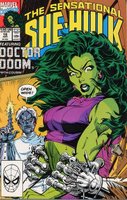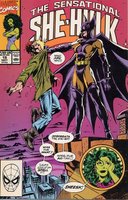 Bob Doom
Bob DoomI have to admit up front that I think Sensational She-Hulk #18 is probably the weakest story in Gerber's run on the series. It doesn't seem to have the sub-text of Gerber's other stories, and the main joke is on the cover.
The basic premise is that She-Hulk gets a client who discovers that his dentist has implanted a receiver into his mouth in place of a filling. The receiver picks up the local radio station and the client wants to sue. It turns out the dentist is Dr. Doom -- Dr. Bob Doom, the fifth cousin of Victor Von Doom. The receiver was actually designed to pick up "an ultra-high-frequency digital signal and transmit it directly to the nervous system." Basically it's a mind-control device, which Bob plans to use to have his richest patients sign over their wealth to him. She-Hulk beats up Bob, and everything's right with the world.
I'm just not seeing any sub-text at all. I'm not seeing anything but a straightforward superhero story, with the exception of the one-note joke about Jen fighting Dr. Doom's fifth cousin. I suppose I could argue that Bob's jealousy of his more famous cousin is some kind of comment on appreciating what you have, despite the relative successes of other family members, but that doesn't seem to ring like a message per se. It seems out of place with the rest of the arc, but fortunately Gerber doesn't end his run on this story.
 Nosferata
NosferataIn many respects, Gerber's last two solo issues of Sensational She-Hulk have a lot of similarities with #10-11, making for a nice bookend effect on Gerber's run. Superficially, there seem to be a lot of comments on some rather trite and superficial aspects of marketing; however, we see again the subtext commentary on living on the fringes of society.
Issue #19 is essentially an origin of a new character: Nosferata. It's largely a parody of Tim Burton's first Batman movie which had come out the year before. It follows the basic plot of the movie, occasionally mimicking the dialogue. Tim and Blair Hayes' daughter Purple (yes, her name's Purple Hayes, but Gerber uses restraint and never uses her complete name like that, allowing the reader to get the joke without drawing excessive attention to it) sees them gunned down by a thug, and she grows up spending her family's resources training herself to avenge her parents' murder. As She-Hulk sets up her law offices, she sees the city blanketed in bat symbols and merchandising that permeates every aspect the city -- down to the toilet paper in the hotel bathrooms -- symbolizing that Nosferata will soon make her presence known.
Issue #20 takes a departure from the Batman movie, but still plays off the Batman mythos. Readers are treated to a romp through Dorkham Asylum with residents like Three-Face, Dogwoman, and Big Al G'houl. They're all led by Jack Serious, an obvious parody and polar opposite of Jack Nicholas' Joker. The plot heads back to Burton territory as Jack Serious tries to inflict his death-dealing chemicals on the population, only to be thwarted by Nosferata in much the same way that Batman defeated Joker in the movie, while She-Hulk takes care of Three-Face, Dogwoman and the others.
On the surface, it doesn't seem much different than a version the movie as seen by the usual gang of idiots at Mad Magazine. We do have two things, though, that stand out.
First is Jack's motivation. Rather than simply being an insane madman, Jack was evidently quite the psychologist. His mandatory villain rant includes the following diabtribe: "The concept of the self evolves along a parallel curve to that of the society it inhabits! As economics eclipsed art, literature, and even science in the cultural consensus of what is significant -- as 'freedom' was reinterpreted to mean merely 'free enterprise,' a radical redefinition of humanity became necessary. To maintain our sanity, we would have to re-conceptualize our selves as disposable ingredients in the industrial process..." Much like She-Hulk's recognition of society's change to a media-driven, commercial enterprise from #11, Jack sees himself as individually irrelevant in the grand scope of what America has become. But in that recognition, whereas She-Hulk -- the hero -- took solace and contentment in her isolation, Jack -- the villain -- wallows in the "fragile wisps of despair." In #11, Gerber was showing the readers the positive aspects of enjoying one's marginalization, whereas he shows the negative aspects of becoming consumed by societal isolation in #20.
Second, it is the combined efforts of She-Hulk and Nosferata both that defeated Jack and his cadre. Gerber had earlier established She-Hulk as an individual on the fringes of society, and he creates Nosferata as a Batman anagram to quickly establish this character as a lone wolf. But -- and here is the important message -- even individuals living on the outskirts of society need companionship from time to time. The message is rather subtle throughout most of the story and indeed most of the arc, but Gerber indulges readers in the final panel by providing his message somewhat more obviously. As Nosferata drives She-Hulk back to her hotel, she notes, "The Dark Princess must walk alone. But a little company on the road is sometimes welcome."
In Conclusion...
Steve Gerber spent a large portion of his run on Sensational She-Hulk treating readers to a wide variety of jokes, gags and puns. Not to mention some classic, old-fashioned superheroics. There's also some social observations -- sans commentary -- that he points out with regard to media and marketing.
But running beneath the surface of the whole series, it seems to me, is Gerber commenting on the position of those pushed to the margins of society. That one can embrace one's "otherness" and live happily on the fringe. But at the same time, one of these marginalized individuals does not need to live in complete isolation. From time to time, one can -- and should -- meet up with other like-minded individuals. We may need to walk alone, but a little company along the way is sometimes welcome.






3 comments:
You know, I caught that last panel about half-way through my reviewing "Cosmic Squish" and it just leapt out as the perfect place to wind up. Once I had that, I was REALLY jazzed to work on this.
Great stuff! Love how you used the alternate cover stuff.
I can't beleive I knew nothing about Gerber before this whole Seven Soldiers of Steve project began!
I've learned so much from wonderful articles like this one.
Thanks, thomas. I've learned a fair bit myself. Kudos to plok for kicking this off.
Post a Comment